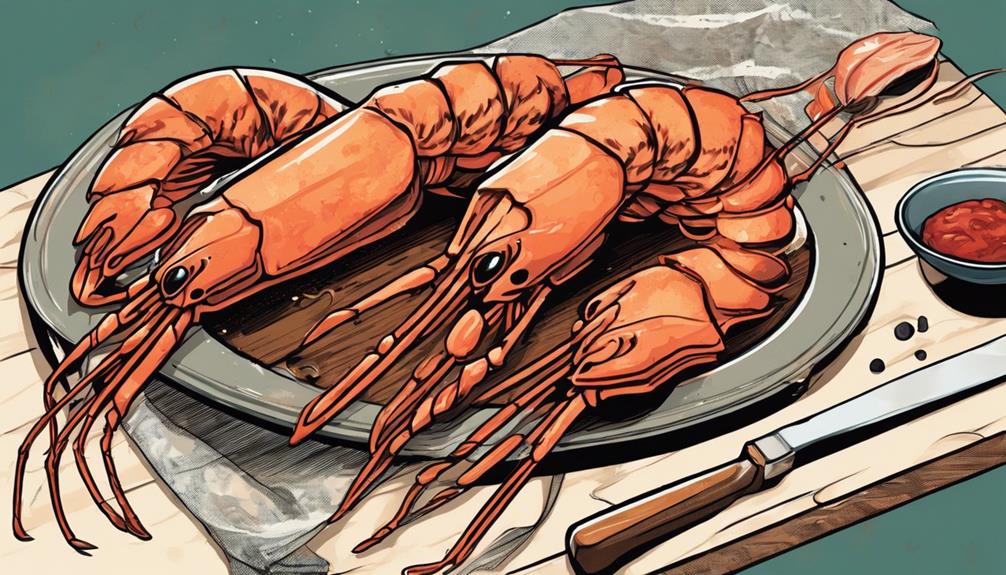To avoid rubbery shrimp, make sure you pick the right size, season well, and choose the proper cooking method like grilling or sautéing. Keep the heat moderate and watch the cooking time closely to prevent overcooking. Once your shrimp turns vibrant pink and slightly firm, remove it promptly, and let it rest before savoring its flavors. This approach will elevate your shrimp-cooking game greatly. For an extra burst of flavor, consider marinating your shrimp beforehand with a blend of olive oil, garlic, and your favorite herbs. If grilling is your method of choice, be sure to follow moist grilled shrimp tips, such as brushing the shrimp with a little oil to lock in their natural juices while preventing them from sticking to the grates. Pair your perfectly cooked shrimp with a fresh salad or pasta for a versatile and crowd-pleasing dish.
Main Points
- Monitor cooking time closely to prevent overcooking and rubbery texture.
- Remove shrimp promptly when opaque to avoid rubbery consistency.
- Properly cooked shrimp should be firm but tender, not rubbery.
- Avoid high heat levels to maintain a delicate shrimp texture.
- Rest shrimp after cooking to enhance juiciness and prevent rubbery texture.
Choosing the Right Shrimp Size
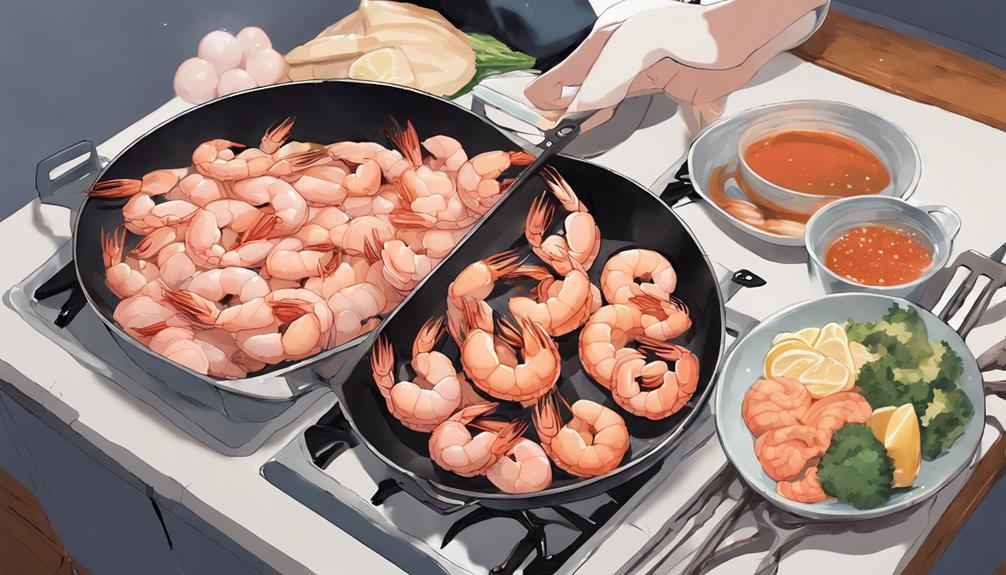
When selecting shrimp for your dish, opt for a size that guarantees consistent cooking and succulent results. Larger shrimp tend to be more forgiving when cooking, as they're less likely to overcook quickly compared to smaller shrimp. Aim for shrimp that are labeled with a number range, such as 16/20 or 21/25, indicating how many shrimp are in a pound. This way, you can maintain a good balance between tenderness and flavor.
Choosing the right shrimp size is important for achieving the perfect texture in your dishes. Larger shrimp are ideal for grilling, sautéing, or roasting, as they can withstand higher temperatures without becoming tough. On the other hand, smaller shrimp work well in dishes where they aren't the main focus, such as pastas or salads.
Properly Thawing Frozen Shrimp
To guarantee your shrimp cooks evenly and retains its natural flavors, mastering the art of properly thawing frozen shrimp is key. Rushing the thawing process can lead to uneven cooking and loss of taste. The best method to thaw frozen shrimp is to plan ahead and transfer them from the freezer to the refrigerator the night before you intend to use them. This slow thawing process allows the shrimp to defrost gently, maintaining its texture and taste.
If you forgot to transfer the shrimp in advance, you can use the cold water method. Place the frozen shrimp in a sealed plastic bag and submerge them in a bowl of cold water. Change the water every 30 minutes to guarantee it stays cold. This method is quicker than refrigerator thawing but requires more attention.
Avoid using hot water or the microwave to thaw shrimp, as they can start cooking the shrimp prematurely, leading to a rubbery texture. By properly thawing your frozen shrimp, you set the stage for a delicious and perfectly cooked dish.
Seasoning Shrimp Before Cooking
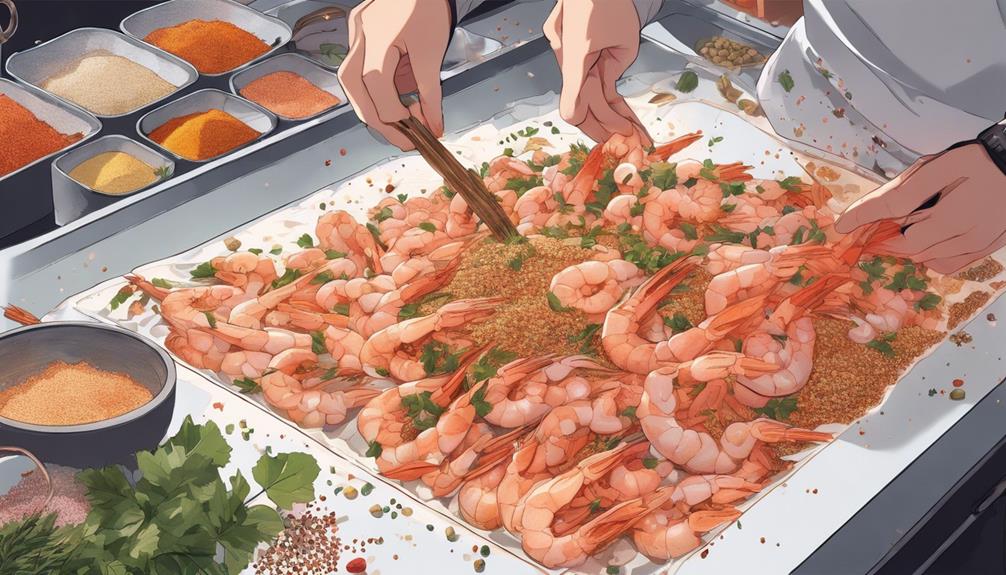
For a burst of flavor in your shrimp dish, consider seasoning the shrimp before cooking with a blend of aromatic herbs and spices. Seasoning shrimp before cooking not only enhances the taste but also helps to prevent it from turning rubbery. A simple yet delicious seasoning mix can be made by combining garlic powder, paprika, salt, pepper, and a dash of cayenne for a little kick. You can also add a squeeze of fresh lemon juice for a zesty touch.
To season your shrimp effectively, start by patting them dry with a paper towel. This helps the seasonings stick better to the shrimp. Then, toss the shrimp in a bowl with the seasoning mix until they're evenly coated. Let the seasoned shrimp sit for about 10-15 minutes to allow the flavors to penetrate the meat.
Using the Correct Cooking Method
To guarantee your shrimp cooks perfectly without becoming tough or overdone, selecting the right cooking method is crucial for achieving a tender and flavorful result. When it comes to cooking shrimp, the method you choose can make all the difference. Here are some ways to make sure your shrimp turns out just right:
- Grilling: Infuse your shrimp with a smoky flavor by grilling them over charcoal or gas. The direct heat sears the shrimp quickly, locking in moisture and flavor.
- Sautéing: Quickly cook shrimp in a hot pan with a bit of oil for a delicious sear. This method is perfect for adding shrimp to pasta dishes or stir-fries.
- Broiling: Utilize your oven's broiler to cook shrimp under high heat. This method quickly cooks the shrimp while giving them a slightly charred exterior, adding depth to the flavor profile.
Monitoring Cooking Time Closely
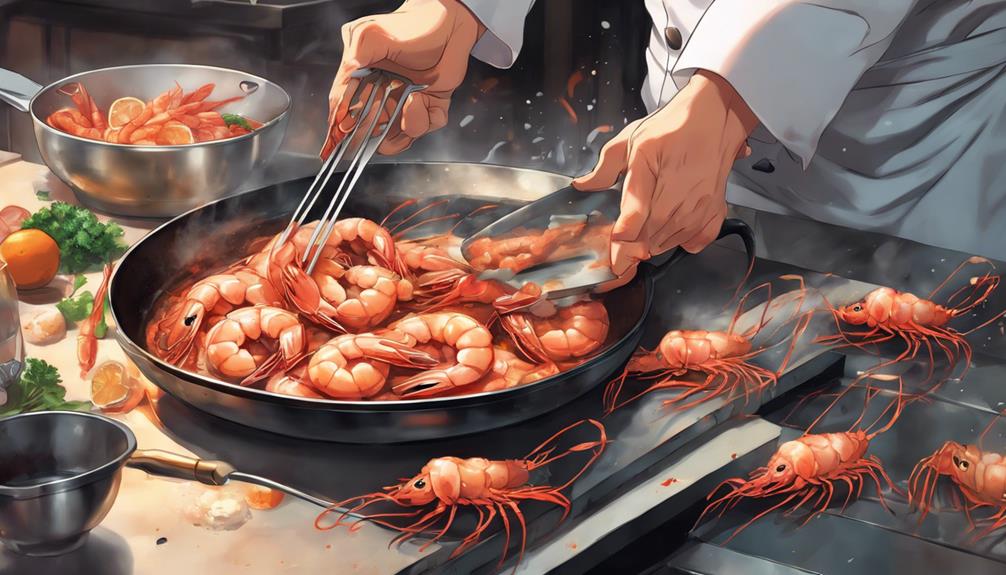
Make sure you maintain a vigilant eye on the cooking time when preparing shrimp to prevent overcooking and maintain that perfect tender texture. Shrimp cook quickly, so every second counts. Whether you're boiling, sautéing, or grilling, set a timer or keep a close eye on the clock.
For medium-sized shrimp, usually, 2-3 minutes per side is all it takes for them to turn pink and opaque, signaling they're ready. Larger shrimp might need a little longer, but be cautious not to exceed 4-5 minutes per side to avoid toughness.
To guarantee even cooking, arrange the shrimp in a single layer in the pan or on the grill. This allows them to cook uniformly and prevents some pieces from being undercooked while others are overdone. Remember, shrimp will continue to cook for a short while even after removing them from the heat source, so factor in this residual heat when gauging doneness.
Avoiding High Heat Levels
Maintain a moderate heat level to guarantee the perfect cooking temperature for your shrimp, preserving their delicate texture and flavor. Cooking shrimp over high heat can lead to overcooking and rubbery texture. By keeping the heat at a moderate level, you can assure that your shrimp cooks evenly and retains its tenderness.
Remember these key points:
- Gentle Sizzle: When you add your shrimp to the pan, listen for a gentle sizzle. This indicates that the heat level is just right, allowing the shrimp to cook through without becoming tough.
- Even Color: Watch for an even color change in the shrimp as they cook. A moderate heat level helps prevent uneven cooking, ensuring that each shrimp is perfectly done.
- Tender Texture: With moderate heat, your shrimp will reach the ideal doneness while maintaining a tender texture. Avoid the temptation to crank up the heat for a faster cook time, as this can result in overcooked shrimp.
Removing Shrimp From Heat Promptly
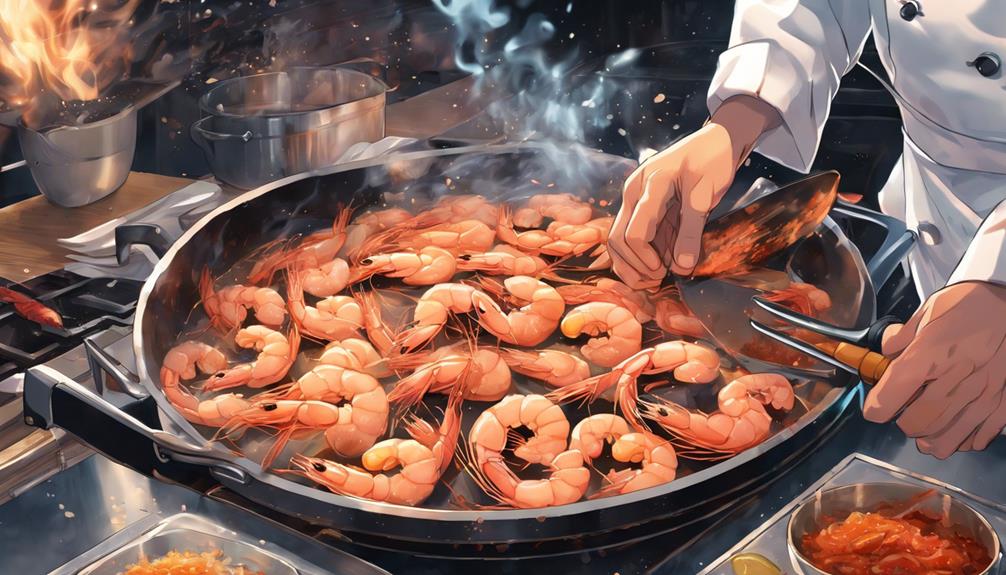
For optimal flavor and texture, promptly remove your shrimp from the heat once they turn opaque and slightly firm to the touch. When cooking shrimp, timing is crucial. Leaving them on the heat for too long can result in a rubbery texture that no one enjoys. As soon as you observe the color change to a beautiful pinkish hue and the flesh turns from translucent to opaque, it's time to act quickly.
The residual heat will continue to cook the shrimp even after you take them off the stove or grill. By removing them promptly, you guarantee they're perfectly cooked and retain their juicy tenderness. Remember, shrimp are delicate creatures of the sea; handle them with care and precision.
Be watchful and have all your tools ready for a quick transfer from heat to plate. This simple step can make a world of difference in the final outcome of your shrimp dish. Enjoy your perfectly cooked shrimp without the dreaded rubbery texture by mastering the art of prompt removal from heat.
Allowing for Residual Cooking
When your shrimp are removed promptly from the heat, allowing for residual cooking can enhance their succulence and flavor profile. The residual heat retained within the shrimp continues to gently cook them even after being taken off the stove or grill. This process helps in maintaining the shrimp's tenderness and juiciness, preventing them from turning rubbery and dry.
To make the most of residual cooking, consider these tips:
- Cover the shrimp: Placing a lid over the cooked shrimp traps the heat, allowing them to continue cooking evenly without direct heat.
- Transfer to a warm plate: Moving the shrimp to a preheated plate keeps them warm and allows for a gradual cooking process, ensuring they remain perfectly tender.
- Let them rest: Allowing the shrimp to rest for a few minutes post-cooking lets the residual heat distribute evenly, resulting in a more flavorful and succulent bite.
Testing Shrimp for Doneness
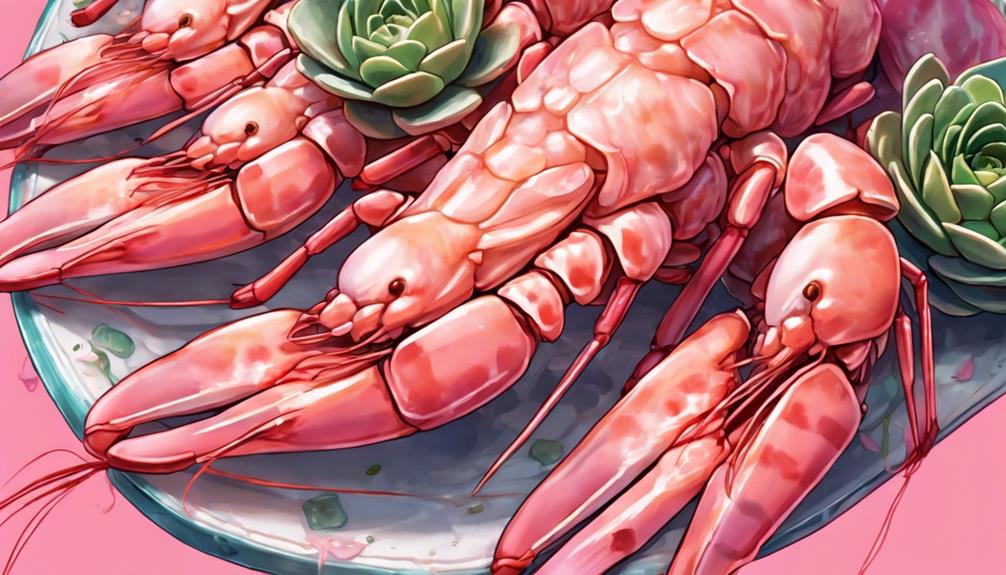
To ensure your shrimp are perfectly cooked, assess their doneness by testing their firmness and color before serving.
When checking for firmness, gently press on the shrimp with your finger. If the shrimp feels soft and squishy, it needs more time to cook. However, if it springs back with a slight give, it's likely done and ready to be removed from the heat.
The color of the shrimp is also a good indicator of doneness. Shrimp turn from gray and translucent to pink and opaque as they cook. Look for a vibrant pink color with slight browning on the edges for ideal doneness.
Letting Shrimp Rest Before Serving
After perfectly cooking your shrimp, allowing them to rest briefly before serving can enhance their flavors and juiciness. When you let the shrimp rest, it gives the juices inside a chance to redistribute, resulting in a more succulent and flavorful bite.
Here are a few reasons why letting shrimp rest before serving is essential:
- Juicy Texture: Allowing the shrimp to rest helps them retain moisture, ensuring they're juicy and tender when you take a bite.
- Enhanced Flavor: Resting allows the flavors to settle and intensify, making each shrimp burst with deliciousness.
- Improved Presentation: Rested shrimp are less likely to fall apart when handled or plated, maintaining their appetizing appearance until the last moment.
Conclusion
Now that you know the secrets to perfectly cooked shrimp, you'll never have to worry about it turning rubbery again.
Just remember to choose the right size, thaw properly, season well, cook with care, and test for doneness.
With these tips, your shrimp will be as tender as a cloud and bursting with flavor.
Say goodbye to rubbery shrimp and hello to shrimp perfection!
